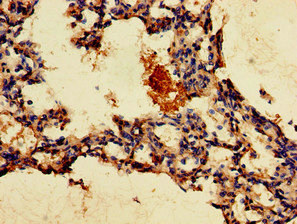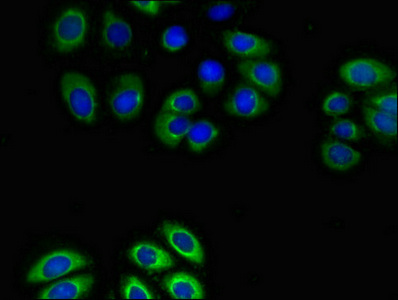GPR4 Antibody
-
货号:CSB-PA009813LA01HU
-
规格:¥440
-
促销:
-
图片:
-
其他:
产品详情
-
产品名称:Rabbit anti-Homo sapiens (Human) GPR4 Polyclonal antibody
-
Uniprot No.:P46093
-
基因名:
-
别名:GPR4; G-protein coupled receptor 4; G-protein coupled receptor 6C.l; GPR6C.l
-
宿主:Rabbit
-
反应种属:Human
-
免疫原:Recombinant Human G-protein coupled receptor 4 protein (285-362AA)
-
免疫原种属:Homo sapiens (Human)
-
标记方式:Non-conjugated
本页面中的产品,GPR4 Antibody (CSB-PA009813LA01HU),的标记方式是Non-conjugated。对于GPR4 Antibody,我们还提供其他标记。见下表:
-
克隆类型:Polyclonal
-
抗体亚型:IgG
-
纯化方式:>95%, Protein G purified
-
浓度:It differs from different batches. Please contact us to confirm it.
-
保存缓冲液:Preservative: 0.03% Proclin 300
Constituents: 50% Glycerol, 0.01M PBS, pH 7.4 -
产品提供形式:Liquid
-
应用范围:ELISA, IHC, IF
-
推荐稀释比:
Application Recommended Dilution IHC 1:20-1:200 IF 1:50-1:200 -
Protocols:
-
储存条件:Upon receipt, store at -20°C or -80°C. Avoid repeated freeze.
-
货期:Basically, we can dispatch the products out in 1-3 working days after receiving your orders. Delivery time maybe differs from different purchasing way or location, please kindly consult your local distributors for specific delivery time.
相关产品
靶点详情
-
功能:Proton-sensing G-protein coupled receptor couples to multiple intracellular signaling pathways, including GNAS/cAMP, GNAQ/phospholipase C (PLC), and GNA12/GNA13/Rho pathways. Acidosis-induced GPR4 activation increases paracellular gap formation and permeability of vascular endothelial cells through the GNA12/GNA13/Rho GTPase signaling pathway. In the brain may mediate central respiratory sensitivity to CO(2)H(+).
-
基因功能参考文献:
- Proton-sensing GPR4 signaling mediated the proton-induced inhibitory effects on the osteogenesis of BMSCs. YAP was the downstream effector of GPR4 signaling. Extracellular pH modulates the osteogenic responses of BMSCs by regulating the proton-sensing GPR4-YAP pathway. PMID: 27256071
- These results suggest that zOGR1, but not GPR4, is also a metal-sensing G-protein-coupled receptor in addition to a proton-sensing G-protein-coupled receptor, although not all metals that activate hOGR1 activated zOGR1. PMID: 28270026
- GPR4 blockade attenuated renal injury after IR and reduced the cell apoptosis through the suppression of CHOP expression. PMID: 29089376
- acidosis/GPR4-induced endoplasmic reticulum stress pathways in endothelial cells may regulate vascular growth and inflammatory response in the acidic microenvironment. PMID: 28134810
- it was demonstrated that GPR4 affects ECs by regulating Notch1, a function that may be important for physiological and pathological angiogenesis. PMID: 27279286
- GPR4 induces angiogenesis via GPR4-induced p38-mediated IL6, IL8 and VEGFA secretion at acidic extracellular pH in squamous cell carcinoma of the head and neck PMID: 27078157
- The results suggested that GPR4 may play an important role in the development of epithelial ovarian carcinoma (EOC), and its overexpression might be required for the angiogenesis, tumor growth, and metastasis of EOC PMID: 23888957
- acidosis/GPR4 signaling regulates endothelial cell adhesion mainly through the G(s)/cAMP/Epac pathway PMID: 22110680
- The mutation of histidine residue at 79, 165, or 269 from the N-terminal of GPR4 to phenylalanine shifted the half-maximal effective concentration (EC(50)) of proton-induced signaling activities to the right, including cAMP accumulation. PMID: 20211729
- Endogenous GPR4 in endothelial cells may be a potential G protein-coupled receptor by which LPC signals proinflammatory activities. PMID: 12805023
- GPR4, a close relative of OGR1, also responds to pH changes, but elicits cyclic AMP formation PMID: 12955148
- sphingosylphosphorylcholine and lysophosphatidic acid are not the ligands for GPR4 and that this receptor may constitutively inhibit ERK1/2 activation PMID: 14567679
- GPR4 and TDAG8 overexpression in human tumors plays a role in driving or maintaining tumor formation PMID: 15221007
- results identify sphingosylphosphorylcholine and its receptor, G protein-coupled receptor 4(GPR4), as critical regulators of the angiogenic potential of endothelial cells PMID: 15857892
- GPR4 may play a critical role in the inflammatory responses activated by lysophosphatidylcholine PMID: 16461426
- GPR4 in brain endothelial cells regulates monocyte transmigration. PMID: 17364894
- lysophosphatidylcholine receptor G protein-coupled receptor 4 (GPK4) was expressed in YPEN-1 cells and triggered the cAMP/protein kinase A/cAMP response element-binding protein pathway, resulting in upregulation of adhesion molecules. PMID: 17437524
- Previously postulated "ligand-independent" signaling of GPR4 is mediated through proton-sensing mechanisms. PMID: 17462861
显示更多
收起更多
-
亚细胞定位:Cell membrane; Multi-pass membrane protein.
-
蛋白家族:G-protein coupled receptor 1 family
-
数据库链接:
HGNC: 4497
OMIM: 600551
KEGG: hsa:2828
STRING: 9606.ENSP00000319744
UniGene: Hs.17170
Most popular with customers
-
-
Phospho-YAP1 (S127) Recombinant Monoclonal Antibody
Applications: ELISA, WB, IHC
Species Reactivity: Human
-
-
-
-
-
-























